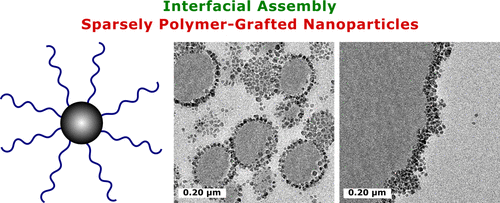当前位置:
X-MOL 学术
›
Macromolecules
›
论文详情
Our official English website, www.x-mol.net, welcomes your
feedback! (Note: you will need to create a separate account there.)
Compatibilizing Immiscible Polymer Blends with Sparsely Grafted Nanoparticles
Macromolecules ( IF 5.1 ) Pub Date : 2020-11-25 , DOI: 10.1021/acs.macromol.0c02108 Husam Alkhodairi 1 , Sebastian T. Russell 1 , Julia Pribyl 2 , Brian C. Benicewicz 2 , Sanat K. Kumar 1
Macromolecules ( IF 5.1 ) Pub Date : 2020-11-25 , DOI: 10.1021/acs.macromol.0c02108 Husam Alkhodairi 1 , Sebastian T. Russell 1 , Julia Pribyl 2 , Brian C. Benicewicz 2 , Sanat K. Kumar 1
Affiliation

|
The use of nanoparticles (NPs) to compatibilize immiscible polymer blends remains an ongoing challenge requiring a high level of control over the NP dispersion and localization. Here, we show that silica NPs “sparsely” grafted with long polystyrene (PS) chains are surfactant-like because they permit core–core, core–matrix, and corona–matrix interactions. When placed at an immiscible polymethyl methacrylate (PMMA)–PS interface, the silica core strongly interacts with one component (PMMA), while the corona mixes with the other (PS). These carefully designed NPs are demonstrated to be efficient stabilizers, even outperforming block copolymers. While such surfactant-like behavior is evident, and understood on the basis of existing ideas, a new concept that we leverage is how the shape of the interfacial free energy profile is affected by the surface grafting density. For an optimally chosen grafting density and graft chain length, we find a nearly symmetric free energy profile as a function of the NP contact angle at the interface, ensuring that the NPs are strongly localized in a region where they are the most efficient in terms of stabilization.
中文翻译:

与稀疏接枝的纳米粒子相容的不混溶聚合物共混物
使用纳米颗粒(NP)使不混溶的聚合物共混物相容仍然是一项持续的挑战,需要对NP的分散和定位进行高度控制。在这里,我们表明,“稀疏”接枝有长聚苯乙烯(PS)链的二氧化硅NP类似于表面活性剂,因为它们允许核-核,核-基质和电晕-基质相互作用。当放置在不混溶的聚甲基丙烯酸甲酯(PMMA)–PS界面时,二氧化硅核与一种组分(PMMA)强烈相互作用,而电晕与另一种组分(PS)混合。这些精心设计的NP被证明是有效的稳定剂,甚至优于嵌段共聚物。尽管类似表面活性剂的行为是显而易见的,并且是在现有思想的基础上理解的,我们利用的一个新概念是界面自由能分布的形状如何受到表面接枝密度的影响。对于最佳选择的接枝密度和接枝链长度,我们发现一个几乎对称的自由能曲线是界面处NP接触角的函数,从而确保NP强烈地定位在它们在以下方面最有效的区域中:稳定。
更新日期:2020-12-08
中文翻译:

与稀疏接枝的纳米粒子相容的不混溶聚合物共混物
使用纳米颗粒(NP)使不混溶的聚合物共混物相容仍然是一项持续的挑战,需要对NP的分散和定位进行高度控制。在这里,我们表明,“稀疏”接枝有长聚苯乙烯(PS)链的二氧化硅NP类似于表面活性剂,因为它们允许核-核,核-基质和电晕-基质相互作用。当放置在不混溶的聚甲基丙烯酸甲酯(PMMA)–PS界面时,二氧化硅核与一种组分(PMMA)强烈相互作用,而电晕与另一种组分(PS)混合。这些精心设计的NP被证明是有效的稳定剂,甚至优于嵌段共聚物。尽管类似表面活性剂的行为是显而易见的,并且是在现有思想的基础上理解的,我们利用的一个新概念是界面自由能分布的形状如何受到表面接枝密度的影响。对于最佳选择的接枝密度和接枝链长度,我们发现一个几乎对称的自由能曲线是界面处NP接触角的函数,从而确保NP强烈地定位在它们在以下方面最有效的区域中:稳定。











































 京公网安备 11010802027423号
京公网安备 11010802027423号